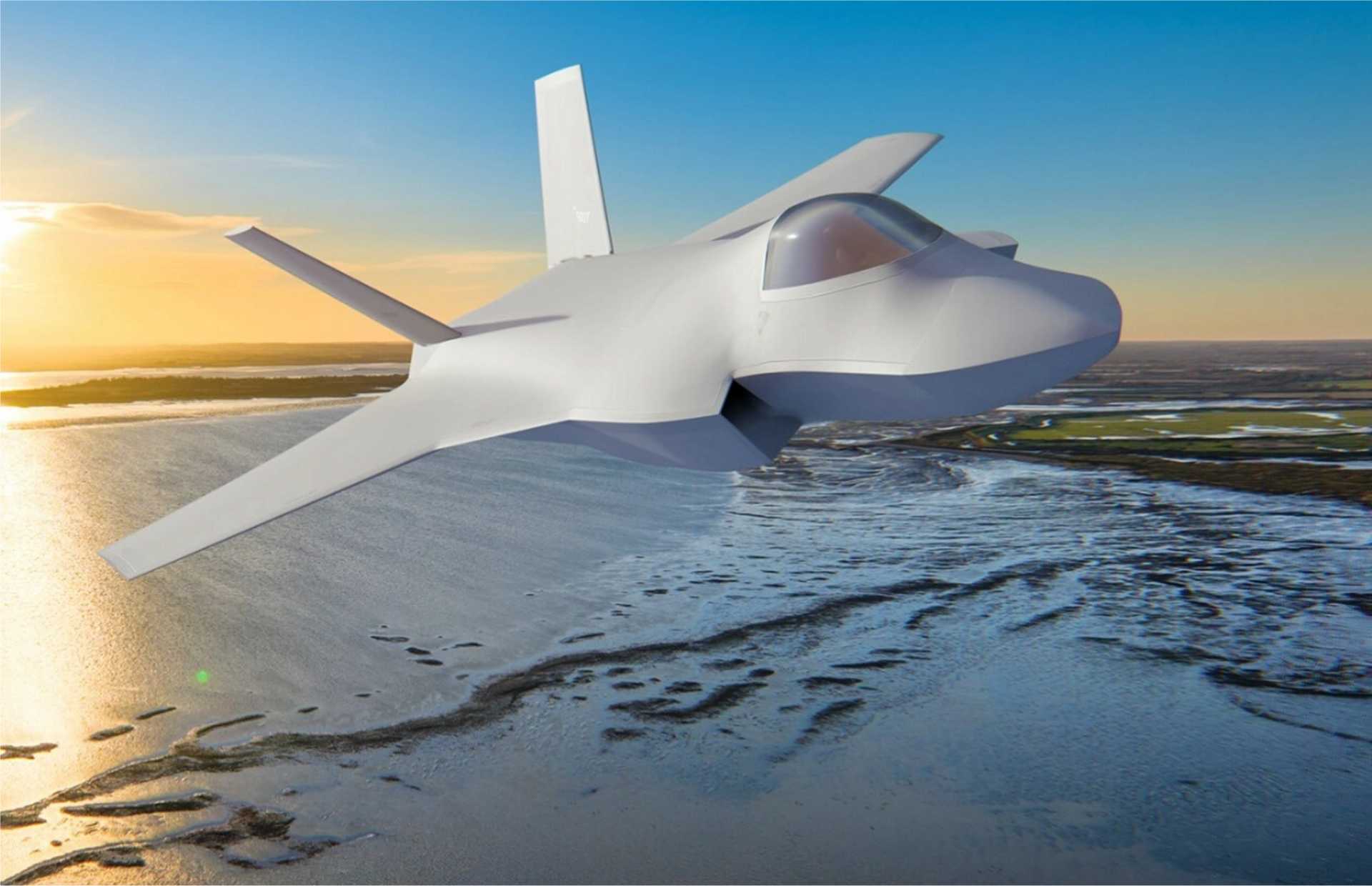Breaking News: BAE Systems reveals Combat Air Flying Demonstrator design for UK next-gen fighter jet program

{loadposition bannertop}
{loadposition sidebarpub}
According to information published by BAE Systems on July 17, 2025, a major milestone has been reached in the UK’s cutting-edge Combat Air Flying Demonstrator program, as two-thirds of the aircraft’s structural weight is now in production. Developed in partnership with BAE Systems, Rolls-Royce, MBDA UK, and the UK Ministry of Defence, this supersonic piloted demonstrator marks the first crewed combat aircraft to be developed in the United Kingdom in four decades. The reveal of its design offers a first glimpse into the next generation of British combat air power, as the aircraft enters advanced stages of manufacturing.Follow Army Recognition on Google News at this link
Artist’s rendering of the UK’s Combat Air Flying Demonstrator showcasing future sixth-generation fighter design. (Picture source: BAE Systems)
Currently being assembled at BAE Systems’ Lancashire facilities, the demonstrator features a main fuselage, wings, and tail fins taking shape with the help of advanced robotic manufacturing and digital engineering tools. These include 3D printing, cobotics, digital twins, and model-based systems engineering. Designed as a testbed for stealth-compatible architecture and next-gen systems, the aircraft is an integral step toward the realization of the UK-Italy-Japan Global Combat Air Programme (GCAP). The demonstrator’s modular airframe and digitally integrated systems aim to de-risk critical technologies that will underpin the sixth-generation fighter planned under GCAP.
With over 300 hours of simulated flight already completed by RAF, BAE Systems, and Rolls-Royce test pilots, the aircraft’s digital twin is generating real-time data on flight dynamics, control systems, and performance during high-intensity manoeuvres. This virtual test campaign is enabling rapid validation cycles and is expected to compress development timelines significantly while enhancing operational reliability. Beyond its technical role, the Combat Air Flying Demonstrator is revitalizing the UK’s sovereign combat air capability, building a highly skilled workforce, and refining industrial processes to ensure competitive advantage in future global defense markets.
The Combat Air Flying Demonstrator program is a cornerstone of the UK’s future air combat strategy and serves as a proof-of-concept platform that directly supports the delivery of GCAP’s sixth-generation fighter aircraft. Its purpose is to mature core capabilities including low observable technologies, novel sensor integration, advanced propulsion systems, and AI-enhanced mission management. It also aims to validate a new approach to program execution through agile development cycles, model-based engineering, and real-time digital collaboration across multiple defense and industrial partners.
The demonstrator will further evaluate key components such as an integrated avionics architecture, sensor fusion, and the ability to team with uncrewed systems. Engine development for the program is being led by Rolls-Royce, which is applying hybrid-electric and adaptive cycle concepts to maximize performance and survivability. Meanwhile, MBDA UK is supporting future weapons integration strategies and engagement solutions to align with GCAP’s broader system-of-systems concept. This collective work is not only redefining combat air technology but is also setting a new standard for collaborative defense innovation within international frameworks.
The UK government’s goal with the Combat Air Flying Demonstrator is to maintain and enhance its position as a global leader in advanced combat air systems, ensuring long-term strategic autonomy in air defense capabilities. By investing in the development of this demonstrator, the UK seeks to accelerate the timeline for sixth-generation fighter deployment, preserve sovereign design and manufacturing expertise, and bolster its defense industrial base. The program is also central to securing high-value defense export opportunities through GCAP partnerships, while strengthening alliances with strategic partners such as Italy and Japan. Through this initiative, the government aims to create a new era of British air combat innovation that delivers operational superiority, economic growth, and international influence.
As the demonstrator nears its first physical flight, it symbolizes not just technological advancement, but the strategic alignment between government and industry to sustain the UK’s leadership in combat aerospace. The momentum generated by this program places the UK in a leading role in shaping sixth-generation air combat capabilities, securing critical knowledge transfer and strengthening transnational cooperation within GCAP.

{loadposition bannertop}
{loadposition sidebarpub}
According to information published by BAE Systems on July 17, 2025, a major milestone has been reached in the UK’s cutting-edge Combat Air Flying Demonstrator program, as two-thirds of the aircraft’s structural weight is now in production. Developed in partnership with BAE Systems, Rolls-Royce, MBDA UK, and the UK Ministry of Defence, this supersonic piloted demonstrator marks the first crewed combat aircraft to be developed in the United Kingdom in four decades. The reveal of its design offers a first glimpse into the next generation of British combat air power, as the aircraft enters advanced stages of manufacturing.
Follow Army Recognition on Google News at this link
Artist’s rendering of the UK’s Combat Air Flying Demonstrator showcasing future sixth-generation fighter design. (Picture source: BAE Systems)
Currently being assembled at BAE Systems’ Lancashire facilities, the demonstrator features a main fuselage, wings, and tail fins taking shape with the help of advanced robotic manufacturing and digital engineering tools. These include 3D printing, cobotics, digital twins, and model-based systems engineering. Designed as a testbed for stealth-compatible architecture and next-gen systems, the aircraft is an integral step toward the realization of the UK-Italy-Japan Global Combat Air Programme (GCAP). The demonstrator’s modular airframe and digitally integrated systems aim to de-risk critical technologies that will underpin the sixth-generation fighter planned under GCAP.
With over 300 hours of simulated flight already completed by RAF, BAE Systems, and Rolls-Royce test pilots, the aircraft’s digital twin is generating real-time data on flight dynamics, control systems, and performance during high-intensity manoeuvres. This virtual test campaign is enabling rapid validation cycles and is expected to compress development timelines significantly while enhancing operational reliability. Beyond its technical role, the Combat Air Flying Demonstrator is revitalizing the UK’s sovereign combat air capability, building a highly skilled workforce, and refining industrial processes to ensure competitive advantage in future global defense markets.
The Combat Air Flying Demonstrator program is a cornerstone of the UK’s future air combat strategy and serves as a proof-of-concept platform that directly supports the delivery of GCAP’s sixth-generation fighter aircraft. Its purpose is to mature core capabilities including low observable technologies, novel sensor integration, advanced propulsion systems, and AI-enhanced mission management. It also aims to validate a new approach to program execution through agile development cycles, model-based engineering, and real-time digital collaboration across multiple defense and industrial partners.
The demonstrator will further evaluate key components such as an integrated avionics architecture, sensor fusion, and the ability to team with uncrewed systems. Engine development for the program is being led by Rolls-Royce, which is applying hybrid-electric and adaptive cycle concepts to maximize performance and survivability. Meanwhile, MBDA UK is supporting future weapons integration strategies and engagement solutions to align with GCAP’s broader system-of-systems concept. This collective work is not only redefining combat air technology but is also setting a new standard for collaborative defense innovation within international frameworks.
The UK government’s goal with the Combat Air Flying Demonstrator is to maintain and enhance its position as a global leader in advanced combat air systems, ensuring long-term strategic autonomy in air defense capabilities. By investing in the development of this demonstrator, the UK seeks to accelerate the timeline for sixth-generation fighter deployment, preserve sovereign design and manufacturing expertise, and bolster its defense industrial base. The program is also central to securing high-value defense export opportunities through GCAP partnerships, while strengthening alliances with strategic partners such as Italy and Japan. Through this initiative, the government aims to create a new era of British air combat innovation that delivers operational superiority, economic growth, and international influence.
As the demonstrator nears its first physical flight, it symbolizes not just technological advancement, but the strategic alignment between government and industry to sustain the UK’s leadership in combat aerospace. The momentum generated by this program places the UK in a leading role in shaping sixth-generation air combat capabilities, securing critical knowledge transfer and strengthening transnational cooperation within GCAP.





